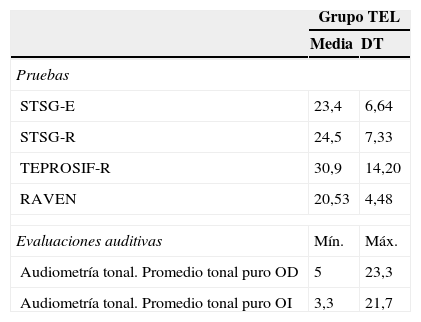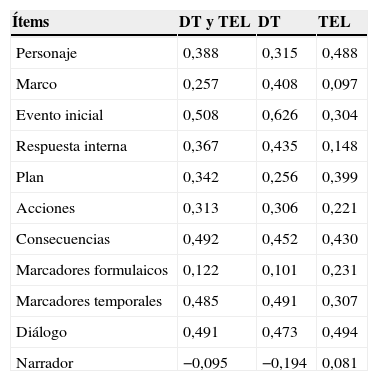Diversos autores han señalado las principales dificultades que al narrar suelen presentar los niños con trastorno específico del lenguaje. Para evaluar las narraciones infantiles existen test basados en la norma, que determinan la presencia o ausencia de elementos en la narración, y test basados en criterio, que evalúan de acuerdo a diversos aspectos que se asumen como centrales en dicha modalidad, indicando distintos niveles de logro. Dentro de este marco, el objetivo del presente trabajo es describir la narración de niños con y sin trastorno específico del lenguaje a través de una versión adaptada del Índice de Complejidad Narrativa, una evaluación basada en criterio. Se trabajó con 38 niños con trastorno específico del lenguaje y 41 con desarrollo típico que asistían a preescolar. Todos ellos vieron un cuento en formato audiovisual y luego lo recontaron con apoyo gráfico. Sus narraciones fueron transcritas y analizadas con el Índice de Complejidad Narrativa adaptado. Los resultaron no solo permitieron observar una diferencia a favor a los niños con desarrollo típico, sino también demostraron que, independiente de la población a la que pertenezca el niño, el dominio incremental de la narrativa se concentra inicialmente en los criterios relacionados con la cadena causal de las acciones y luego se extiende a otros. Además, el Índice de Complejidad Narrativa adaptado demostró ser una forma de evaluación válida y confiable para monitorizar los avances de los niños en la producción narrativa.
Several authors have described the problems that children with specific language impairment present in their narratives. There are 2 ways of assessing the narrative performance of children: through norm-referenced test, that determine the presence or absence of narrative elements; and through the criterion-reference test, which allows to describe the narratives of children on the basis of the level of development of certain elements or skills. In this context, the purpose of this study is to describe the narrative performance of children with and without specific language impairment using an adapted version of the Index of Narrative Complexity, which is a criterion-referenced test. We worked with 38 children with specific language impairment and 41 children with typical development, all attending kindergarten. Each children watched a story in audiovisual format and then retold it with a graphic support. Their narratives were transcribed and analyzed with the adapted version of the Index of Narrative Complexity. The results not only allowed observing a difference in favor of children with typical development, but it also showed that, with independence to the population to which the child belonged, the incremental development of the narrative is initially devoted to the elements associated to the causal chain of the actions an then it extended to other elements. Moreover, the adapted version of the Index of Narrative Complexity proved to be a valid and useful form of assessment that enables the speech therapist to monitor the progress of individuals in the narrative production.
Artículo
Comprando el artículo el PDF del mismo podrá ser descargado
Precio 19,34 €
Comprar ahora














